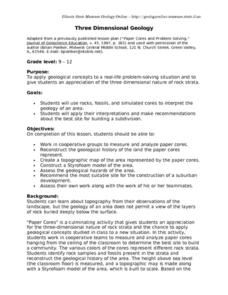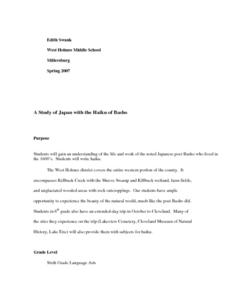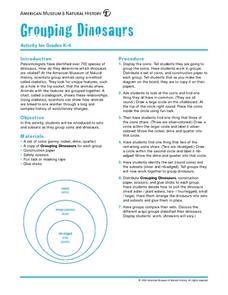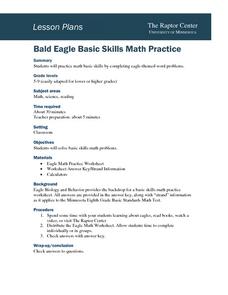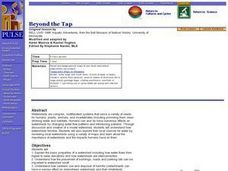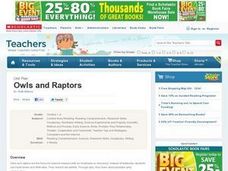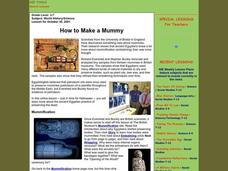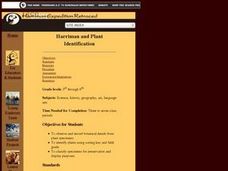Curated OER
Entertaining Vancouver's Youth During World War II.
Learners investigate relevant period documents and artifacts and have the
opportunity to replicate a 1943-44 entertainment experience by viewing a program
of World War II era motion pictures on site at Vancouver's historic...
Curated OER
Three Dimensional Geology
Students use rocks and fossils to interpret the geology of an area. They use prior knowledge and make recommendations about where to build a subdivision based on the rocks.
Curated OER
A Study of Japan with the Haiku of Basho
Sixth graders explore haiku poetry and the works of the Japanese poet Basho. They review characteristics of haiku poetry and other forms of poetry. After they write three or more haiku poems, they illustrate one of them and share with...
Curated OER
Got Biodiversity?
Students examine the concept of biodiversity. Using the internet, they complete small activities in which they work together. Using the information they collected, they create a class book, make murals and write in their journals.
Curated OER
What is a Fossil?
Learners determine what a fossil is and distinguish between body fossils and trace fossils. They examine pictures of fossils and determine which represents a trace or body fossil.
Curated OER
Grouping Dinosaurs
Students investigate sets and subsets as they group coins and dinosaurs. Using scissors and provided sheet, they sort dinosaurs according to their commonalities. Their groupings are shared with the class.
Curated OER
Bald Eagle Basic Skills Math Practice
Students solve basic skills math problems involving eagles. They read and discuss facts about eagles and view a video. They complete the Eagle Math worksheet and check their answers. They create additional problems and solve them.
Curated OER
Mayonnaise Jar Greenhouse
Third graders examine the Greenhouse Effect, how it operates and finally allows the student to experiment using a model created in the classroom. They explain how the greenhouse effect affects the Earth.
Curated OER
Beyond the Tap
Students explain the basic properties of a watershed including how water flows from higher to lower elevations and how watersheds are interconnected. They comprehend how the placement of buildings, roads, and parking lots can be...
Curated OER
Fossils
Fourth graders act as paleontologists and attempt to figure out the environment where various fossils would have existed. They explain how fossils can be used to make inferences about past life, climate, geology, and environments.
Curated OER
Using Solar Energy
Students experiment to determine the effect of solar energy on the temperature of water. For this renewable resources lesson, students measure the temperature of water in a flask that is exposed to sunlight. They relate their results to...
Curated OER
Why Cladistics?
Students explore how biological classification is intimately associated with evolution.
Curated OER
Owls and Raptors
Students investigate the predator-prey relationship of owls and raptors. They examine a variety of resources about owls and raptors, develop a list of vocabulary words, dissect owl pellets and identify what owls eat, and play a...
Curated OER
Environmental Hazards
Students identify environmental hazards on a simulated field trip. They analyze the exposure and suggest methods to eliminate or reduce exposure to toxic sources.
Curated OER
Introduction to Pinning Insects
Students are introduced to how to properly pin insects by reviewing insect morphology, insect orders and recognizing that the second and third thoracic segments contain large locomotor muscles that bind to the pin.
Curated OER
Salty Sea Water
Young scholars conduct an experiment to find out if there is salt in the ocean. In this scientific inquiry lesson, students pour a cup of salt water onto an aluminum plate and observe the changes over a few days. Young scholars complete...
Curated OER
Solving Math Problems In the Real World
Upper elementary and middles schoolers discuss and solve real world applications of math. They use formulas for volume and percents to answer real world questions. In the second part of the activity, groups write and solve word problems....
Curated OER
When Clay speaks
Learners listen as the teacher reads "When Clay Sings," by Byrd Taylor. They discuss clay, and view a variety of clay items. Students watch a video clip "Interests in One of a Kind Pots." They watch a demonstration on working with clay....
Curated OER
A Neighborhood Expedition
Students plan and conduct an expedition through their neighborhood based on the techniques used by the Harriman Expedition to Alaska in 1899. They research the Harriman expedition on the internet and then create a route and collection...
Curated OER
Texas Treasures
Students explore the meanings of the word "treasure," and examine the use of clay in the construction of buildings in San Antonio, Texas. They examine clay artifacts, and watch a video about pottery artist, Harding Black. Students then...
Curated OER
How To Make a Mummy
Young scholars explore the process of mummification through a British website. They read about why the process began and how it is done. They can follow along in the process in how to make a mummy as well.
Curated OER
What Do We Learn From the Repartiation of Alaska Native Artifacts?
Students observe and evaluate evidence of Alaska Native cultural symbols and artifacts. They research historical data from a variety of primary resources, including the Harriman expedition journals, related web sites, oral accounts,...
Curated OER
Harriman and Plant Identification
Students observe and record botanical details from the plant specimens. They identify plants using sorting key and field guide and classify specimens for preservation and display purposes.
Curated OER
Can We Be Both Conservationists and Consumers?
High schoolers explore their role as consumers and conservationists and what roles they play in today's economic climate. They explore resource allocation issues. Students analyze data and draw comparisons between historical and...



